
When Will the Pandemic Cure Be Worse Than the Disease?
As government mandated lockdowns to combat the coronavirus pandemic affect a rising share of the global population, fewer will die of COVID-19, as well as other transmissible diseases. But how should we weigh those benefits against the costs of unemployment, social isolation, and widespread bankruptcies?
MELBOURNE/OXFORD – As of today, almost half the world’s population, nearly four billion people, are under government-mandated lockdowns in an effort to stop the spread of the COVID-19 coronavirus.